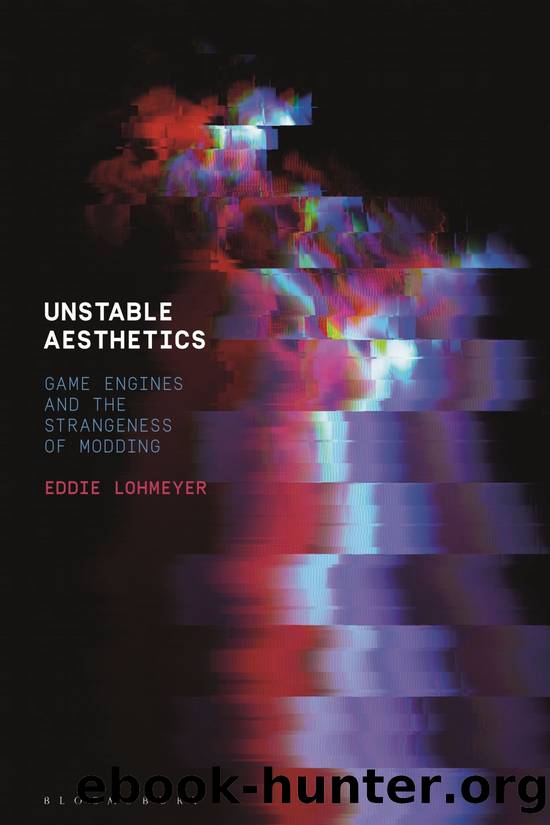Unstable Aesthetics by Eddie Lohmeyer

Author:Eddie Lohmeyer
Language: eng
Format: epub
Publisher: Bloomsbury Publishing Plc
Figure 3.3 JODI, Untitled Game, 1996â2001. Installation view, Street Digital, Museum of the Moving Image, 2012. Mods projected onto large scrims. Photograph by Daniel Love. © Museum of the Moving Image and Daniel Love.
In the following section, I unearth a media archaeology of the Quake engine and its unique computational techniques that produce the gameâs real-time 3D spaces. Drawing from Matthew Kirschenbaum, I propose a forensic analysis of Quake through what he refers to as a grammatology: a reading of the working components of an inscription technology.7 Here, I trace the mechanisms of the Quake engine to JODIâs deconstruction of its code at the forensic level of inquiry, to the formal materiality of Untitled Game and the playerâs mimetic engagement with its abstract spaces. By unveiling how a game engine works, its âengine-nessâ we might say, and how JODI upend its standard operations through the rendering of anamorphosis, we can consider how modding practices make strange conventional gameplay of the first-person shooter.
A Grammatology of the Quake Engine
After the release of Doom II in 1994, Romero and Carmack began work on a 3D version of a previous 2D game concept called Quake: The Fight for Justice, that like Doom, was inspired by playing Dungeons and Dragons. The game was slated to be a medievalesque RPG with a warrior avatar named Quake equipped with a giant hammer. The comprehensive FAQ document QUAKETALK 95 created by game developer and Quake archivist Joost Schuur in October of 1995 provides a detailed library of interviews, articles, and programming logs on the Quake engineâs development starting in the summer of 1994. In an interview from November of the same year, Romero addresses the advanced rendering the 3D engine stating that:
the technology in quake [sic] will be much better than in doom [sic] . . . the graphics will use 3-D rendered models, unlike the 2-D images in doom [sic] . . . so if you walk around a pillar, youâll see it in full 360 degrees, as opposed to only eight different rotations in doom [sic]. Youâll also be able to move in six different directions, and theyâll [have] much better animation. Weâre also adding cool cinematic sequences that take place while youâre playing the game. Basically, doom will feel stiff compared to quake [sic].8
Carmack began programming a potential 3D engine throughout 1995 but because of technical limitations with rendering and frame rate, both Romero and Carmack changed the direction of Quake from a slower, world-exploring RPG to a frenetic, fast-paced shooter in the tradition of Doom. Developments on the reworked engine included Carmack as main programmer, Michael Abrash assisting with assembly optimization and algorithms, and additional programming by John Cash. Game design was handled by Romero along with American McGee, Sandy Petersen, and Tim Willits, and art direction by Adrian Carmack, Kevin Cloud, and Paul Steed. The game featured an aggressive industrial soundtrack produced by Trent Reznor of Nine Inch Nails to accompany the chaotic gameplay. Released on June 22, 1996, the final build of
Download
This site does not store any files on its server. We only index and link to content provided by other sites. Please contact the content providers to delete copyright contents if any and email us, we'll remove relevant links or contents immediately.
| Anthropology | Archaeology |
| Philosophy | Politics & Government |
| Social Sciences | Sociology |
| Women's Studies |
The remains of the day by Kazuo Ishiguro(7551)
Tools of Titans by Timothy Ferriss(6948)
The Black Swan by Nassim Nicholas Taleb(6192)
Inner Engineering: A Yogi's Guide to Joy by Sadhguru(5897)
Giovanni's Room by James Baldwin(5878)
The Way of Zen by Alan W. Watts(5800)
The Six Wives Of Henry VIII (WOMEN IN HISTORY) by Fraser Antonia(4791)
The Power of Now: A Guide to Spiritual Enlightenment by Eckhart Tolle(4755)
Astrophysics for People in a Hurry by Neil DeGrasse Tyson(4620)
Asking the Right Questions: A Guide to Critical Thinking by M. Neil Browne & Stuart M. Keeley(4576)
12 Rules for Life by Jordan B. Peterson(3734)
The Ethical Slut by Janet W. Hardy(3503)
Skin in the Game by Nassim Nicholas Taleb(3461)
Housekeeping by Marilynne Robinson(3401)
The Art of Happiness by The Dalai Lama(3384)
Double Down (Diary of a Wimpy Kid Book 11) by Jeff Kinney(3273)
Skin in the Game: Hidden Asymmetries in Daily Life by Nassim Nicholas Taleb(3264)
Walking by Henry David Thoreau(3234)
12 Rules for Life: An Antidote to Chaos by Jordan B. Peterson(3203)
